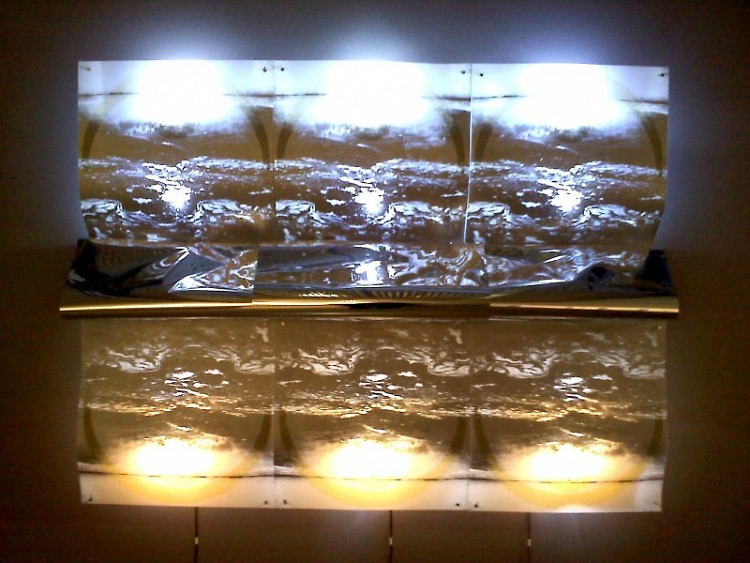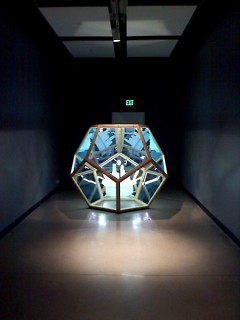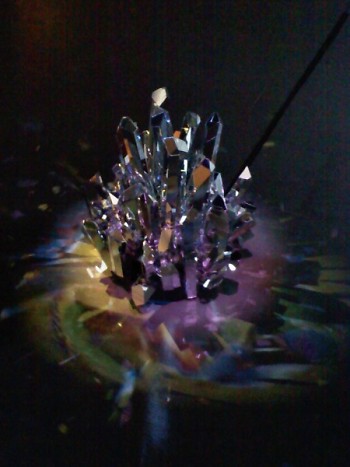Utopia is defined by Merriam-Webster as "an imaginary and indefinitely remote place," as well as "a place of ideal perfection especially in laws, government, and social conditions." Dystopia is defined as "an imaginary place where people lead dehumanized and often fearful lives." In the imagined future of the Utopia/Dystopia exhibition currently on display at UICA, humans are largely absent. Evidence of former existence is present in the neat rows of golden plaque artifacts in Relics: Morals of Utopia Deconstructed Within A Geometric Matrix by Gerald di Falco, and in the vignette of a ruined Interior of a Detroit Home by Whitney Sage, as well as many other works. The only piece in which people are prominently visible is Places With No Names by Darryl Lauster, but they seem unrelatable, distant, contained within monitors. One of the four screens simply shows the artist sitting among foliage in what looks like a backyard, absently petting a chicken on his lap, staring off into the distance.
I encountered few other patrons while walking the sparsely filled concrete galleries on a late Saturday afternoon, amplifying the sense of solitude, the feeling of arriving to a place long after party-goers have left. Indeed, the opening reception of this exhibit was held in conjunction with an End of The World Party on December 21, 2012, a few weeks before my visit. It is not difficult to imagine revelers surrounding Glimmer, an impressive work by Scott Andrew and Jonathan Armistead, which makes effective use of a space on the 4th floor and is also visible from a balcony on the 5th floor. It's a large piece, consisting of shards of broken mirrors fused together to resemble a cluster of crystals. Music plays and colorful projected light throws reflections on the walls and momentarily flash in the viewer's eyes as the mass rotates. I was mesmerized and started daydreaming about the 1980 fantasy film Xanadu, thinking how cool it would be to see people circling the artwork in roller skates.
Downstairs, on the same level as the theater, is another piece which uses mirrors, only these are two-way mirrors. When looking at the hexagonal structure one does not see themself, but instead a model of an all-white futuristic city suspended within, repeated and fractured into many different infinities, in Peter Everett's Utopia. Can an idealized place ever successfully exist and contain humans, or do humans need to be removed in order to maintain the perfection?
The aesthetic conveyed by most contemporary art, especially new media, tends to be sleek, sterile, very controlled. Even when clay and unfinished wood are used, they are made into precise, perfect forms. Objects are infused with ideas but can lack warmth or charm, making it difficult to "fall in love" with them. The medium is a successful vehicle to convey a sense of detachment. Taken as a whole, this vision of the future is missing enthusiasm, optimism, a human touch. There are no flying cars, no haphazard graffiti, no evidence of desire. There is not even a dark, bloody future depicted.
An introduction of the exhibit on the wall states, "...The artists whose work is included in Utopia/Dystopia seem to recognize that, in a very real sense, the future is always here...the form it will take is visible in our present day world, one of near infinite possibilities."
The path these artists have chosen to show is one that is precisely arranged (even when broken), and mostly colorless, foretelling a future and reflecting a present mired in dissatisfaction and detachment.
Disclosure: I'm a UICA member.
The Rapidian, a program of the 501(c)3 nonprofit Community Media Center, relies on the community’s support to help cover the cost of training reporters and publishing content.
We need your help.
If each of our readers and content creators who values this community platform help support its creation and maintenance, The Rapidian can continue to educate and facilitate a conversation around issues for years to come.
Please support The Rapidian and make a contribution today.



